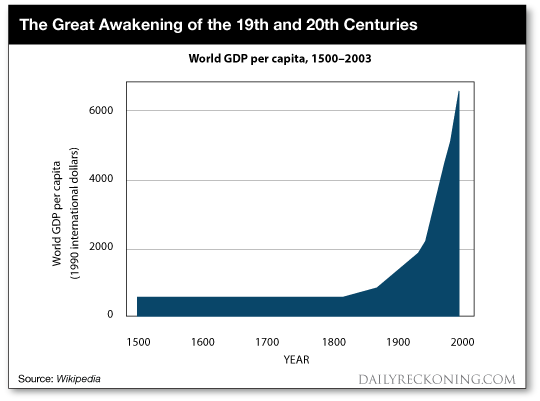By Brian Maher
This post The Hard Limits of Progress appeared first on Daily Reckoning.
Until the 19th century, technological and economic progress advanced inch by agonizing inch.
The fastest transportation in A.D. 1776 was the fastest transportation in 1776 B.C. — the horse.
Maritime commerce flowed to the fickle rhythms of wind and tide, as it had since the opening chapter.
Life was intensely agricultural.
Night was lit by candle and torch… to the extent it was lit at all.
And economic growth?
The Western world’s annual growth rate through 1820 averaged a millimetric 0.06% a year, according to Angus Maddison, economic historian.
That’s 6% a century.
The history of global GDP per capita, 1500–2003:
The chart reveals three centuries of economic dusk.
Then in the mid-to-late-19th century, a light bulb flickered on — literally…
An unlikely series of inventions came along in the mid-to-late-19th century that raised the curtain on a golden age of technological and economic progress… an era of such razzle-dazzle that had no equal in history.
The electric light bulb turned night into day. Electric power brought progress on a thousand fronts.
The railroad, steamship and internal-combustion engine finally put period to the “homely plod of hoof and sail” that paced transportation for millennia.
The telegraph, telephone and radio unhorsed the twin tyrannies of time and distance.
Industry exploded. So did populations. And cities.
The result was a “special century” of technological and economic progress, 1870–1970.
These inventions were so thunderous and so transformative that some argue their impact can never be equaled.
Robert Gordon is an economist at Northwestern University.
Last year he wrote a book called The Rise and Fall of American Growth. From which:
The economic revolution of 1870–1970 was unique in human history, unrepeatable because so many of its achievements could happen only once… the revolutionary century after the Civil War was made possible by a unique clustering, in the late-19th century, of what we will call the “Great Inventions”… What makes the period 1870–1970 so special is that these inventions cannot be repeated.
“With a few notable exceptions,” Gordon adds, “the pace of innovation since 1970 has not been as broad or as deep as that spurred by the inventions of the special century.”
It seems there’s justice in this view.
The light bulb can only be invented once.
It can be improved, refined, brought within sight of the perfections.
But not reinvented. Edison remains on his throne.
And is it coincidence that broader American prosperity began petering around 1970… as the “great inventions” ran their course?
It is by no means the only answer. But perhaps a partial answer.
What truly astounds is the pace of it all.
They crammed more technological progress into that one special century than a previous dozen combined.
Man walked this ball some 40,000 years before he took his fledgling flight above the dunes of Kitty Hawk in 1903.
The 12-second “flight” managed about a dozen feet of altitude… and 120 feet of distance.
Sixty-six years later, man was rocketing to the moon.
Impossible — but there it is.
Has there been progress since 1970?
Only a fool would argue there hasn’t.
But it seems more …read more
Source:: Daily Reckoning feed
The post The Hard Limits of Progress appeared first on Junior Mining Analyst.

